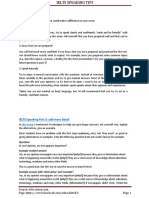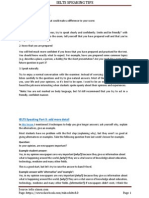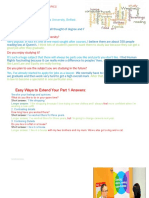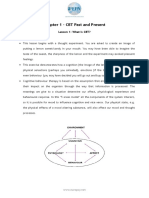Saeed Lahijani English Language Academy
IELTS Speaking Test: Structure, Sample Questions,
& Answers
The IELTS Speaking test consists of three parts, each designed to assess
different aspects of your spoken English:
1. Part 1: Introduction & General Questions (4-5 minutes)
2. Part 2: Long Turn (Cue Card) (3-4 minutes, including 1 min prep)
3. Part 3: Discussion & Abstract Questions (4-5 minutes)
Let’s break them down with examples and strategies.
Part 1: Introduction & General Questions
This section is about everyday topics (work, studies, hobbies, hometown,
etc.).
Sample Questions & Model Answers
1. Q: What do you do—work or study?
A: I’m currently a university student majoring in Computer Science. I’m
particularly interested in artificial intelligence and its applications in
healthcare.
2. Q: Do you enjoy living in your hometown? Why/why not?
A: Yes, I love my hometown because it’s a peaceful place with lush
greenery and friendly locals. However, I wish there were more job
opportunities here.
3. Q: Do you prefer texting or calling people?
A: I’d rather text because it’s more convenient—I can reply at my
own pace. But for essential matters, I think phone calls are better
since they avoid misunderstandings.
Tips for Part 1:
✔ Keep answers concise yet detailed (2-3 sentences).
✔ Use natural vocabulary (e.g., "I’m really into…" instead of "I like…").
✔ Avoid memorized answers; sound spontaneous.
1|Page
� Saeed Lahijani English Language Academy
Part 2: Long Turn (Cue Card)
You’ll receive a topic and have 1 minute to prepare before speaking for 1-
2 minutes.
Sample Cue Card:
"Describe a skill you learned that you’re proud of."
What the skill is
How you learned it
Why it’s useful
Why you’re proud of it
Model Answer:
learning graphic design, which I started a year ago through an online course,
is something that I’m really pleased with. My goal was to create
professional social media content. Initially, I found Photoshop and Canva
quite challenging to master. However, through daily practice, I gradually
developed strong design skills. Now, I work as a freelance designer
creating branding materials for small businesses. This experience has
been incredibly rewarding financially, as I earn regular income from
projects. More importantly, it's significantly boosted my self-confidence.
Looking ahead, I'm excited to continue developing this valuable skill. I’m
currently exploring animation techniques to expand my creative offerings,
and I’ve even started mentoring beginners in my free time. These
opportunities have shown me how one new skill can open countless doors,
both professionally and personally.
Tips for Part 2:
✔ Structure your answer: Introduction → Details → Conclusion.
✔ Use past tenses if describing an experience.
✔ Add personal emotions ("I was thrilled when…").
2|Page
� Saeed Lahijani English Language Academy
Part 3: Discussion & Abstract Questions
This part involves deeper questions related to Part 2’s topic.
Sample Questions & Answers:
1. Q: Why is learning new skills important for personal growth?
A: Acquiring new skills keeps the brain active, increases employability,
and can even lead to new passions. For example, learning coding
might open doors to tech careers. Beyond professional benefits, it
builds adaptability and self-confidence when facing life's challenges.
Personally, mastering graphic design taught me that perseverance
leads to measurable progress, which is incredibly motivating.
2. Q: Do you think schools teach enough practical skills?
A: Not really. Many schools focus on theory rather than hands-on
skills like financial literacy or communication, which are crucial in
adulthood. This gap becomes apparent when graduates struggle with
real-world tasks like budgeting or workplace collaboration. Some
progressive institutions are now incorporating project-based
learning, but systemic change is still needed.
3. Q: How has technology changed the way people learn skills?
A: Technology has revolutionized learning—platforms like YouTube
and Coursera offer free tutorials, making education accessible to
anyone with internet access. The interactive nature of digital
learning, with instant feedback and global communities, accelerates
skill acquisition dramatically. Now, someone in a remote village
can master programming just as effectively as a university student,
democratizing education.
Tips for Part 3:
✔ Give balanced opinions ("On one hand… on the other hand…").
✔ Use linking words (However, Additionally, Consequently).
✔ Support answers with examples or reasons.
3|Page
� Saeed Lahijani English Language Academy
Key Strategies for a High Band Score (7.0+)
✅ Fluency & Coherence:
Speak without long pauses; use fillers naturally ("Well, let me
think…").
Organize ideas logically (First, Secondly, Finally).
✅ Lexical Resource (Vocabulary):
Avoid repetition (e.g., use "beneficial" instead of "good").
Incorporate idioms/phrases ("It was a steep learning curve").
✅ Grammar & Accuracy:
Mix tenses correctly (e.g., "I’ve been playing piano since I was a
child").
Use complex sentences ("Although it was difficult, I persisted").
✅ Pronunciation:
Stress key words and maintain natural intonation.
Record yourself to identify unclear sounds.
Final Advice
Practice daily with a timer to simulate test conditions.
Listen to native speakers (podcasts, interviews) to improve rhythm.
Get feedback from teachers.
4|Page





















































































